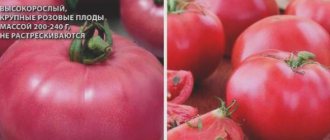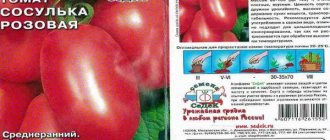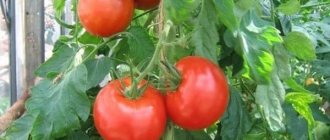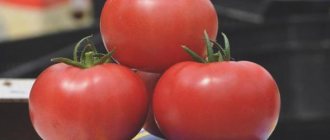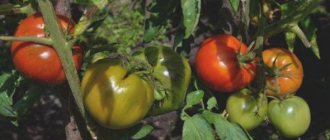Japanese tomato selection is famous throughout the world; a good example of this is Pink Pioneer F1, intended for cultivation on an industrial scale. The new product was entered into the State Register only 2 years ago. Of interest to farmers and gardeners.
| Height | Landing location | Ripening time | Fruit color | Fruit size | Origin | Fruit shape |
| Medium height | Greenhouse, Open ground | Mid-early | Pink | Average | Hybrid | Heart-shaped |
TOP 6 tomato hybrids for the greenhouse.
Every time, in February or early spring, we begin to frantically select and search for tomato seeds for planting in our greenhouses.
Personally, I experiment every year, spend a lot of money on expensive domestic and imported seeds, but I don’t always get the expected result.
As a result of many years of observations, I came to the conclusion that it is still better to plant hybrid varieties in a greenhouse.
Having scoured the Internet, read numerous reviews from gardeners and based on my own experience, I have identified for myself, in addition to my favorite varieties “Mondial”, “Pozanno”, “Purple Pride of Wessel” and “Kibo”, six more good varieties of tomato hybrids for the greenhouse.
Pay attention to them too. Maybe these hybrids will suit and like you too
1. PINK CLEAR F1-
Israeli hybrid of the first generation. Refers to early-ripening indeterminate pink-fruited tomatoes. Ripening period is 95-100 days.
This type of tomato is one of the leaders among the tall pink varieties, due to its high yield and resistance of the fruit to cracking.
Tomatoes set even in hot weather conditions; the fruit does not become smaller during prolonged cultivation. Tomato fruits weighing 250-300 grams are very tasty, juicy and fleshy and at the same time dense.
The hybrid is resistant to major diseases.
2. HUNNY MOON F1
– a French universal hybrid adapted for cultivation in various regions.
The tomato is indeterminate, a balanced plant with short internodes. Each cluster has 4-5 fruits. The first brush is formed above the fifth leaf, the subsequent ones - after two or three leaves. The plant does not grow into the jungle, due to which it is well ventilated. This hybrid is resistant to late blight and blossom end rot.
According to reviews from gardeners, the taste of the fruit is excellent. Weight reaches 200-250 grams, the fruits are very beautiful, pink with a raspberry tint
Well, what is very important for those who grow tomatoes for trade, tomatoes have a dense consistency, but at the same time they are very tasty, as befits a tomato whose name is “HANNY”, that is, honey
3. BIG BEEF F1 –
a hybrid of Dutch breeding, which received the title of winner of the national AAS winner competition held in the USA.
This hybrid belongs to the mid-early, highly productive, indeterminate tomatoes that have powerful growth. The bush is simply strewn with fruits that do not become smaller during long-term cultivation.
The fruits have a flat-round shape. They have an excellent taste, as well as a bright aroma. The average fruit weight is 280-330 g.
It is very resistant to Verticillium and Fusarium wilt, Alternaria stem cancer, nematode, tobacco mosaic virus, gray leaf spot, and when other hybrids growing nearby disappear, it simply continues to live and bear fruit abundantly.
4. ALAMINE F1
– Dutch medium-fruited indeterminate tomato, early hybrid, resistant to temperature changes.
It showed itself to be the earliest among indeterminate hybrids, demonstrated the fastest ripening among other hybrids with a large number of set tomatoes.
The average weight of a tomato is 180-200 g, with the normal weight on the first bunches being 230-260 g.
This hybrid ripens very early and tolerates heat easily.
Excellent for both indoor and open ground. In greenhouses, these tomatoes show very good results, on par with tomatoes bred only for indoor soil.
5. SUPERNOVA F1 –
An excellent new product from Clause breeders.
Ultra-early, low-growing, productive, determinate red tomato - fruits with an average weight of 250 grams ripen in 60-62 days.
The fruits have an interesting shape – a round tomato with a “spout”. Rich red color, very sweet, juicy, ripens at the same time, does not burst and is transported without problems.
6. PINK BUSH F1 –
bred by Japanese breeders, the determinate, low-growing hybrid is an early hybrid. Equally suitable for growing in greenhouses and open ground. Resistant to major tomato diseases.
Its main advantages: early ripening and high yield. The fruits have a rich pale pink color and weigh on average 180-210 g. The taste is good.
Resistant to diseases.
Plant tomatoes, experiment. I am sure that among the presented hybrids you will find the best one for you.
Description of the Pink Pioneer tomato and recommendations for growing
The hybrid tomato variety Pink Pioneer F1 was bred by Japanese breeders and has long been recognized as one of the most popular similar products on the entire market. The tomato is intended for industrial cultivation; the variety came to Russia relatively recently - mention of it appeared in the state register several years ago.
What is a Pink Pioneer tomato?
Now this breeding novelty is in good demand among amateur summer residents who have greenhouses on their plots. This selection is also cultivated by farmers with the goal of selling the resulting fruits.
Characteristics and description of the variety:
- Tomato Pink Pioneer f1 belongs to the mid-early tomato varieties.
- The first fruits on the bushes appear 70 days after the formation of seedlings.
- The bushes are distinguished by powerful trunks and tall growth. This variety is classified as an indeterminate type.
- One of the most important characteristics is the taste of a ripe tomato - it is described as harmonious, since sweetness and sourness are combined perfectly.
- The fruits themselves are medium in size, their weight varies between 200-220 g.
- Tomatoes can be stored for quite a long time and tolerate transportation well over long distances.
- The species is not affected by diseases such as nematodes, silver leaf viruses, and mosaics.
Experts say that on average, about 28 kg of fruit can be harvested from 1 m² of planted Pink Pioneer tomato bushes. Such a yield can be achieved if a summer resident or farmer grows the variety in greenhouse conditions, using equipment of the appropriate quality.
Ripe fruits can be eaten raw, as well as used for various types of snacks and added to salads. If tomatoes are cooked, for example, when making soups or sauces, their taste becomes slightly better. In addition, Pink Pioneer tomatoes added to hot dishes have a positive effect on human health. They have a fairly dense pulp, which allows them to be used in the process of preservation.
The result of selection for endurance
Since tomatoes come from tropical America, in our latitudes they like the warmth of closed ground. But excessive heat, large differences in day and night temperatures, lack of breeze - all this leads to poor pollination. In critical situations, the fruits do not set or turn out to be ugly.
The problem can be solved in two ways:
- establishing cross ventilation;
- planting specially bred hybrids.
Pink Rise F1 tomatoes are just capable of successfully setting fruit in extreme temperatures. This does not mean that they do not need a breeze. These tomatoes are always prepared for the worst, but hope for the best, realizing their full potential under optimal conditions.
The main scourge of amateur tomato greenhouses is aggressive infections. Sometimes they take away almost the entire tomato crop, negating financial and labor costs. For breeders, task No. 1 is to obtain resistant plants. Unfortunately, complete resistance to late blight does not yet exist, but the Pink Rise F1 hybrid is relatively hardy even to this scourge. And in general it is not affected by brown spot (cladosporiosis) - the next most harmful disease after late blight. In addition, the variety rarely suffers from gray rot. Not susceptible to fusarium and verticillium wilt, tobacco mosaic virus, and root nematodes.
Based on all the characteristics, the Pink Rise F1 tomato is one of the best greenhouse hybrids. It bears fruit successfully only with increased nutrition and timely formation. The experience of vegetable growers shows that in open ground the returns are significantly lower.
Tomato varieties resistant to cladosporiosis
Twice champion 2009 Messages: 3588 Registered: 12/22/2006, 10:05 AM Interests: from the fence to lunch
https://forum.prihoz.ru/viewtopic.php?p=468037#p468037 Occupation: plumber-san From: Middle East of the Moscow region - Malakhovka Thanked: 1205 times Thanked: 4188 times
Status: Offline
Tomato varieties resistant to cladosporiosis
Message from AI » 02/02/2013, 09:45
I propose to collect in this topic our experience in growing varieties resistant to cladosporiosis.
In your messages, please talk only about varieties.
About growing technology, soil preparation, seeds - in the relevant topics - “Tomatoes”. "Late blight", etc. This topic is only about varieties and their properties, for reference purposes; you should not make it too long.
I had to grow the following.
Our Masha F1 (Ilyinichna) - good taste (4), the tomatoes are dense, easy to grow, ripen well, tolerate low light, I’ve been planting them every year for many years;
Centaur, Victoria, Red Comet, Titanic (all F1 from Ilyinichna) - inferior to Our Masha in taste and yield, I tried them once each.
Vezha (Belarus) - tolerant to CS, i.e. does not get sick for a long time, the fruits are smaller than those of Our Masha, the taste is also almost 4.
Delicacy (Allen) - quite stable, fruits are pink, dense, taste 4 points, bush in a greenhouse one meter high, does not like shade, I grow two stems almost every year. According to Allen's director Sheboldaev, his parents include a certain Chinese variety. Productivity is average (for me it’s 3 kg/bush)
Evpator, Funtik (Gavrish) - refused because they are not very tasty
Malika F1 – didn’t like the taste
Space Star F1, like Nasha Masha, turned out to be resistant to cladosporiosis; they have similar transportable, thick-walled fruits; in both varieties, both sugars and acids are present at the beginning of reddening, i.e. taste, but Masha is still a little tastier.
Lemon Boy F1 (Royal Sluis) - Yellow, dense large fruits, taste 4, productive
That's probably all. I haven’t come across any fruits with excellent taste and soft, tender fruits that are resistant to cladosporiosis.
Messages: 12842 Registered: 05/10/2010, 17:48 From: Moscow Thanked: 2311 times Thanked: 4856 times
Status: Offline
Re: Tomato varieties resistant to cladosporiosis
Posted by Katie2 » 02/02/2013, 11:05
Dear! Yes, it's a sore subject. because I don’t like to spray with chemicals because of cladosporiosis and I haven’t done that.
Giant - the taste is so-so. Fruitful. Good for pasta. Vitador F1 Semko. The taste is still better than store bought. Slightly sweet. Swallow - I tried it once. No taste. But I remember that the leaves were preserved for a long time. Well, of course, Pink Paradise. And the like that I will try. For example, Pink Pioneer, Pink Bush. There is also this Pink Rise. They wrote to me that he is not much different from Pink Paradise. Taste. We need to check with one. But Pink Lady differs in taste, i.e., not as tasty (according to outside reviews)... As for the resistance to cladosporiosis of these latter ones, which I don’t sow, I can’t answer. Etude F1 - taste very good, tomato taste. I have been sowing for a long time. The old seeds remain, I’m trying to sow again and evaluate... Vologda F - good taste, i.e. sweetish. It bears fruit for a long time. Klondike - I don’t remember, but it seems that we are also tolerant of cladosporiosis. It’s just that he was overcome more than others by the whitefly. With her, she removed the leaves from it. It was on him that she especially sat. Business Lady F1 is slightly susceptible to cladosporiosis. A late variety, which will even come in handy. We eat as soon as we close the season. The taste is good. I also grabbed a lot of something else from Ilyinichna, where the package says it is resistant to cladosporiosis. And I try. I'll report back later. Those who grow tomatoes in a greenhouse can answer you. That is, cladosporiosis is the scourge of a greenhouse where the humidity is above 60%. If you type the words tomato for cladosporiosis in Yandex, it gives several varieties - a hybrid. Many grow child varieties on OG, but we don’t know from them.
Description of the tomato variety Pink Pioneer
Tomato Pink Pioneer from the Japanese company Sakata in Europe has long occupied its niche among hybrids bred for industrial production. In Russia, the salad variety has only recently become known. It was included in the state plant register two years ago. The new selection is equally of interest to an amateur summer resident with a greenhouse and to a farmer who grows produce for sale.
Main characteristics
The hybrid is high-yielding; in terms of fruit ripening, it is mid-early. You can expect the first ripe tomatoes 70 days after germination. The bushes are powerful, tall, and belong to the group of indeterminate type tomatoes.
An important characteristic of any variety is the taste of a ripe tomato; plum-shaped fruits have a harmonious, good taste of the pulp. The fruits are of medium size, the average weight does not exceed 200 g. The manufacturer’s stated weight is 220 g. The fruits are stored well, there are no complaints about loss of presentation during transportation.
Attitude to diseases is expressed by resistance to the following pathogens:
- nematode;
- brown spot;
- mosaic virus;
- silver leaf virus;
- wilt (verticillium, fusarium).
Description - brief instructions for caring for and growing tomatoes from Sakata contains recommendations for forming a bush. In greenhouses, tall tomatoes of the indeterminate type are recommended to be formed into one stem.
This scheme facilitates care, eliminates thickening of plantings, and guarantees good lighting of the entire plant. The taste of fruits on properly formed plants is sweeter due to better lighting.
Productivity and purpose of use
During testing, the variety showed a yield of 27.6 kg/sq.m. When grown in a greenhouse and following good agricultural practices, any summer resident can achieve a similar result.
Characteristics
The fruits are moderately large, flat-round, very even. The weight of an average tomato is 230-280 g. The taste is very pleasant, delicate, sweet with a slight sourness. High content of sugars and beta-carotene. The seed chambers are small. Glossy, dense skin and rich pink color make tomatoes very attractive and protect the fruits from cracking.
You can compare the weight of Pink Lady tomatoes with others in the table below:
| Variety name | Fruit weight |
| Pink Lady | 230-280 grams |
| Diva | 120 grams |
| Yamal | 110-115 grams |
| The Golden Fleece | 85-100 grams |
| Golden heart | 100-200 grams |
| Stolypin | 90-120 grams |
| Raspberry ringing | 150 grams |
| Caspar | 80-120 grams |
| Explosion | 120-260 grams |
| Verlioka | 80-100 grams |
| Fatima | 300-400 grams |
Tomatoes are of the salad type and are used for preparing appetizers, soups, sauces, and juices. Tomatoes are suitable for baby food, as their acidity is lower than that of red-fruited varieties.
Review of tomato Pink
Pink was not created for industrial cultivation. It is designed for amateur vegetable growers who value not only tasty, but also beautiful fruits. Thanks to the early ripening of this tomato, your labor costs are reduced, you will have to water and feed less. Pink doesn't need protection from disease.
We suggest you familiarize yourself with How to glue penoplex together - types of glue and features of the installation process
“We planted a Pink Rise tomato last year. The variety is magnificent. The tomatoes are very beautiful, pink in color, all the same size. They made salads, juices, and tomato paste from them. The taste of the fruit is wonderful. I advise everyone to grow this variety.”
“We planted a Pink Rise tomato at the dacha. The bushes turned out to be very tall. The tomatoes are beautiful. I had to tie my wrists. The whole family took care of the tomatoes. They watered, hilled up the soil, and fertilized. Plants were also sprayed against diseases. But I was very pleased with the harvest.”
“Our climate is cool, but Pink Rise tomatoes have grown well. They were grown in a greenhouse. The bushes were tied to supports. Sweet tomatoes, weighing up to 500 g. The taste is excellent. In addition, the fruits can be stored for a long time, and they do not lose their qualities.”
What is a Pink Pioneer tomato?
Now this breeding novelty is in good demand among amateur summer residents who have greenhouses on their plots. This selection is also cultivated by farmers with the goal of selling the resulting fruits.
Characteristics and description of the variety:
- Tomato Pink Pioneer f1 belongs to the mid-early tomato varieties.
- The first fruits on the bushes appear 70 days after the formation of seedlings.
- The bushes are distinguished by powerful trunks and tall growth. This variety is classified as an indeterminate type.
- One of the most important characteristics is the taste of a ripe tomato - it is described as harmonious, since sweetness and sourness are combined perfectly.
- The fruits themselves are medium in size, their weight varies between 200-220 g.
- Tomatoes can be stored for quite a long time and tolerate transportation well over long distances.
- The species is not affected by diseases such as nematodes, silver leaf viruses, and mosaics.
Experts say that on average, about 28 kg of fruit can be harvested from 1 m² of planted Pink Pioneer tomato bushes. Such a yield can be achieved if a summer resident or farmer grows the variety in greenhouse conditions, using equipment of the appropriate quality.
Ripe fruits can be eaten raw, as well as used for various types of snacks and added to salads. If tomatoes are cooked, for example, when making soups or sauces, their taste becomes slightly better. In addition, Pink Pioneer tomatoes added to hot dishes have a positive effect on human health. They have a fairly dense pulp, which allows them to be used in the process of preservation.
The fruits are also good in making tomato juice. At the same time, useful elements are preserved. This juice is recommended to be consumed to prevent a number of diseases, including cancer.
See also
Characteristics of the tomato Snowfall f1 and description of growing the hybrid
Read
Features of cultivation
Now this breeding novelty is in good demand among amateur summer residents who have greenhouses on their plots. This selection is also cultivated by farmers with the goal of selling the resulting fruits.
Characteristics and description of the variety:
- Tomato Pink Pioneer f1 belongs to the mid-early tomato varieties.
- The first fruits on the bushes appear 70 days after the formation of seedlings.
- The bushes are distinguished by powerful trunks and tall growth. This variety is classified as an indeterminate type.
- One of the most important characteristics is the taste of a ripe tomato - it is described as harmonious, since sweetness and sourness are combined perfectly.
- The fruits themselves are medium in size, their weight varies between 200-220 g.
- Tomatoes can be stored for quite a long time and tolerate transportation well over long distances.
- The species is not affected by diseases such as nematodes, silver leaf viruses, and mosaics.
Ripe fruits can be eaten raw, as well as used for various types of snacks and added to salads. If tomatoes are cooked, for example, when making soups or sauces, their taste becomes slightly better. In addition, Pink Pioneer tomatoes added to hot dishes have a positive effect on human health. They have a fairly dense pulp, which allows them to be used in the process of preservation.
Pink is grown through seedlings. Sow the seeds in early or mid-April so that the plants are 30–35 days old by the time they are planted in the greenhouse. Disinfection of seeds and soil can be neglected, since the crop will be ready for harvest in the summer, before the period when tomatoes begin to be massively affected by late blight.
Tomato variety Pink is best grown through seedlings
At the stage of the first true leaf, pick up the seedlings. Due to the very short seedling period, you can do without fertilizing at all or apply one a week after picking, but no later than a week before planting in a permanent place. Use special fertilizers for seedlings:
- Fertika Lux;
- Agricola;
- Blank sheet.
If the sowing was done immediately in a greenhouse or greenhouse, then you can feed it with a natural infusion of nettle, bird droppings or mullein. But the smells of such fertilizers are not suitable for a city apartment.
There are 2 options for preparing for landing:
- A week before planting seedlings, add well-rotted humus or compost to the ground - a bucket per 1 m² - and a glass of ash for the same area. Dig up the soil with fertilizers, level it and water it.
- On the day of planting fertilizer, add a handful of humus and 1 tbsp to each hole. l. ash, you can use special mixtures for tomatoes (Red Giant, Gumi-Omi), mix with soil. Then fill the holes with water, wait until it is absorbed, and start planting.
The distance between tomato bushes should be 30 cm
At the time of planting, 30-day-old bushes will still be short, but after 2–3 weeks they will need tying to stakes or a trellis. For intensive fruiting, water your tomatoes regularly—at least once a week—and feed them every 10–14 days. From the beginning of flowering, apply only complex fertilizers containing nitrogen, phosphorus, potassium in equal proportions, as well as microelements (boron, copper, iron, calcium, manganese, etc.). The universal BioMaster concentrate is well suited for these purposes.
Growing tomatoes need support
Nowhere does it say how to shape Pink bushes. Moreover, it is not clear what type of growth this variety has. The State Register states that the bush is indeterminate, that is, with unlimited growth. Such tomatoes are grown in 1 stem, removing all the stepsons. However, the description on the Gavrish website indicates a height of up to 150 cm, which means that growth still stops.
I would grow such a tomato with 2 stems, leaving 1 stepson under the first flower cluster for safety. And I would make one or two bushes as control ones - 1 stem. Then, during the harvest period, it will be possible to compare the productivity of different formations and draw conclusions for the next year: how to correctly form Pink in order to get the maximum benefit from it.
Description and characteristics of the variety
Tomato Pink Pioneer F1 is an indeterminate tall hybrid. The bushes are tall and strong. Description of the shoots:
- stem height 1.8-2 m;
- moderate branching and foliage;
- There are 5-7 tomatoes on the bunches.
The ripening period is mid-early - 90-105 days from germination.
Fruit characteristics:
- average weight 200-230 g;
- shape like cream;
- bright crimson color;
- the pulp is fleshy, low-seeded;
- sugar level 5%;
- the skin is durable.
The hybrid is resistant to many pathogens - mosaic, silver, spot, verticillium, fusarium.
How to raise Pink Lady
The cultivation of tomatoes of the described variety is carried out by sowing seed material into seedlings.
Preparing seeds for planting
The seeds of this variety have one clear difference: they do not require disinfection before planting. To start growing, just soak them in a growth stimulator. This should be done in regions with a warm climate in late February - early March. If we are talking about colder areas of the country, it is advisable to plant seeds for seedlings in the last ten days of March. This applies to Siberia, the Urals, and all other regions where the summer is short and not hot.
You can make the soil for planting yourself, or you can purchase a ready-made version. The best choice is an earthen mixture, the acidity of which is quite low. You can bring soil from your summer cottage, borrowing it from cabbage, cucumber, and carrot beds.
Features of cultivation
Pink Lady seeds should be planted for seedlings at the end of February. Soil with a neutral acidity level works best. It is good to achieve this indicator by mixing ordinary soil with humus, you can add a little ash.
The resulting soil must be distributed into containers, in which the tomato seeds will begin their long journey. They need to be deepened by about 1.5 centimeters. Before the planting procedure, the seeds are soaked in a growth stimulator for 12 - 14 hours. There is no need to disinfect the material, because the seeds are subjected to all necessary procedures before sale.
To create the most suitable growing conditions in the container, it must be wrapped in film and placed in a warm place. Emerging sprouts need constant lighting
You need to moisten the soil carefully, in moderation, because tomatoes are not fans of too wet soil
After the plant has formed 2 true leaves, picking should be done. After transplantation, it is necessary to apply complex fertilizer. Re-feed the plants before planting them in a permanent place.
The time during which seedlings should be grown depends on the time of year:
- spring - 42 days;
- summer - 35 days;
- winter - 63 days.
Transplanting the first seedlings into the ground becomes possible after May 15, when night temperatures mostly remain above zero. In order for the survival rate to be as good as possible, you should spill the holes with potassium permanganate. At the time of transplantation, the trunks should be tied to reinforcement or trellis.
Gardeners need to pay attention to this fact: a more rational way is to grow tomatoes on a trellis. It is imperative to remove the stepsons and monitor the formation of the bush
It should have 1 or 2 stems.
Rules of care
Tomato Pink Lady is a crop that is very favorable to heat. Seed germination can begin already at 10 – 15 °C, and the optimal temperature for keeping bushes ranges from 23 to 25 °C. If during the growth period the variety finds itself in cool conditions, and the temperature drops to 15 ° C, you can lose buds and, as a result, a significant part of the harvest. High temperatures, as well as frost, can have a detrimental effect.
The rules for caring for the Pink Lady variety are quite simple:
- disinfection of the land before planting;
- need for tying;
- soil acidity requirements;
- installation of supports;
- watering with water at room temperature.
To create an ideal microclimate, you can plant greens in parallel with tomato bushes: celery, parsley, mint. These herbs will be an excellent pest repellent.
